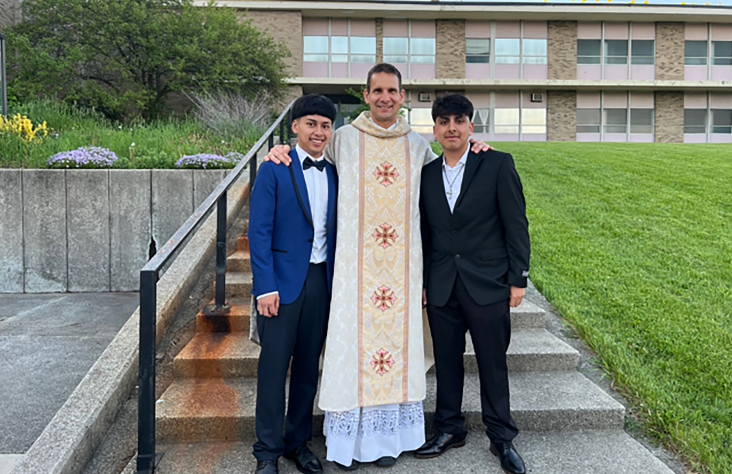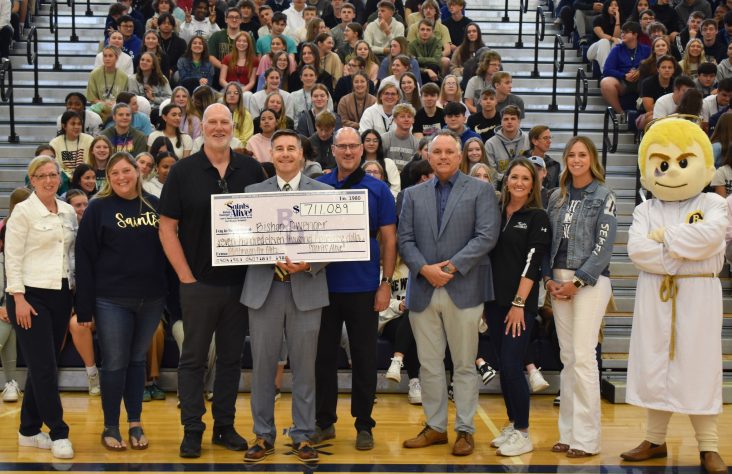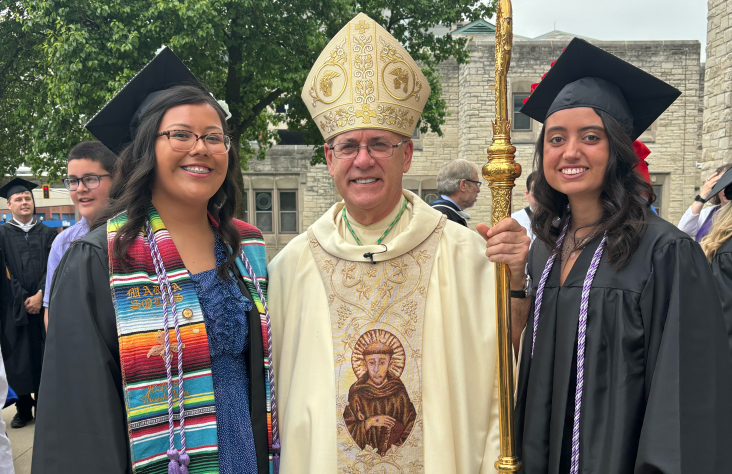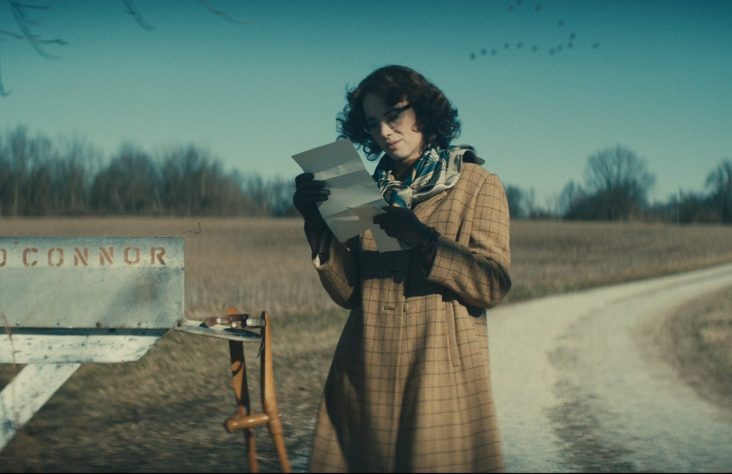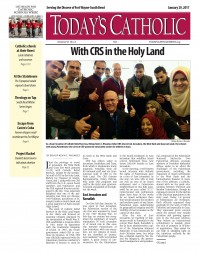February 1, 2017 // Bishop's Column: In Truth and Charity
Bishop Rhoades visits Middle East with CRS
I had the privilege to travel to Jerusalem, the West Bank and Gaza last week (January 15-22) with Catholic Relief Services. Hosted by the wonderful staff of CRS in the Holy Land, Bishop Joe Vasquez of Austin, Texas, and I, along with two CRS staff from the U.S., seven board members and benefactors and the CRS regional director participated in the trip. I was especially delighted that one of the participants was from our diocese: Tom Veldman, parishioner of St. Joseph Parish in South Bend and a great supporter of Saint Joseph High School.
The work of Catholic Relief Services in the Holy Land began in the 1940s and focused on assisting refugees displaced by the devastation of World War II. CRS established a program office in 1961 under an agreement with the Hashemite Kingdom of Jordan. In 1967, the Israeli government asked CRS to continue its presence. In 1999, CRS was officially registered with the Palestinian National Authority’s Ministry of Interior to carry on its work in the West Bank and Gaza.
CRS has offices today in Jerusalem, Bethlehem and Gaza, from which it implements many programs. Presently, there are 49 national staff and six international staff of CRS in the Holy Land. The CRS Country Representative, Hilary Dubose, who leads CRS programs and staff in the Holy Land, graciously hosted and guided us throughout the week.
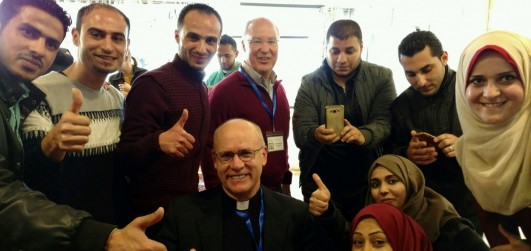
As a board member of Catholic Relief Services, Bishop Kevin C. Rhoades visited CRS sites in East Jerusalem, the West Bank and Gaza last week. He is shown with young Palestinians who serve at CRS-sponsored community centers for children in Gaza.
For more photos from Bishop’s trip visit his Facebook page here.
Or the Today’s Catholic photo gallery here. All photos contributed by Bishop Kevin C. Rhoades.
East Jerusalem and Ramallah
Our first full day, January 16, was spent in East Jerusalem, the Palestinian section of the city that was annexed by Israel in the 1967 Six-Day War. To this day, no country has recognized the legitimacy of Israel’s annexation of East Jerusalem or of Israeli rule in this area. The 308,000 Palestinians of East Jerusalem, with rare exception, are not citizens of Israel, but are classified as “permanent residents” with very limited rights. A great source of consternation for the Palestinians is the Israeli settlement in East Jerusalem that solidifies Israeli control. Settlement blocs now house 200,000 Israelis in East Jerusalem.
In the morning, a well-known Israeli attorney who defends the rights of Palestinians gave us a tour of East Jerusalem. At one stop, we were able to look out over an area of an Israeli settlement and a Palestinian neighborhood on two hills separated by an area called “E-1.” Controversial and problematic plans have been in the works for an Israeli settlement there that would separate the northern and southern parts of any future Palestinian state, undermining its geographical integrity and the viability of East Jerusalem as the capital of that state.
After the tour of East Jerusalem, we travelled 10 kilometers north to Ramallah in the central West Bank. Ramallah is the de facto administrative capital of the Palestinian National Authority. It was historically an Arab Christian town, but today has a Muslim majority. We visited the Muqata’a, the government headquarters and presidential compound of the Palestinian National Authority. Two Palestinian officials, strategic advisors of President Mahmoud Abbas, spoke to us about the challenges of the Palestinian government, including the expansion of Israeli settlements in the West Bank and the humanitarian disaster in Gaza. One of the advisors, a Catholic, shared with us the good relationship between Christian and Muslim Palestinians, though he expressed concern for the decline of the Christian population in the Holy Land. Today, 1.8 percent of Palestinians are Christians. Both officials expressed deep gratitude for the work of CRS in Palestine and especially in Gaza. They expressed grave concern about the present very volatile situation and growing opposition to the two-state solution. They believe an international commitment is needed, given the lack of progress in bi-lateral negotiation. They asked for our help in shedding light on the injustices suffered by the Palestinian people.
Church of the Holy Sepulchre and Latin Patriarchate
We began our second day in Jerusalem with Mass at the chapel on Mount Golgatha, within the Church of the Holy Sepulchre, followed by a tour of this holiest church in the world, on the site of Our Lord’s crucifixion and resurrection. If you have been there, you know the indescribable experience of entering the Edicule, the shrine that encloses Jesus’ empty tomb. Kneeling at the tomb, I prayed for justice, peace and reconciliation in the Holy Land. Presently, the Edicule is being restored and is covered with scaffolding. I was happy that it is still open for pilgrims. A few months ago researchers found the original rock surface, the bed of Jesus’ burial, under the marble slab where people pray. The limestone cave walls of the tomb are also intact.
After the tour and breakfast in the Christian Quarter of the old city, we visited the residence and offices of the Latin Patriarch of Jerusalem near the Church of the Holy Sepulchre. The Latin Patriarch is the Bishop of all the Latin Roman Catholics in Israel, the Palestinian Territories, Jordan and Cyprus (approximately 150,000 Catholics today). Last year the Patriarch retired, so the Patriarchate is presently governed by an Apostolic Administrator, Archbishop Pierbattista Pizzaballa, an Italian Franciscan.
We had a very friendly audience with Archbishop Pizzaballa, who expressed his deep appreciation for the work of CRS in the Holy Land. He shared with us his concern about the diminishing population of Christians in Jerusalem, now numbering only 12,000. He wants the Church to be a living presence in Jerusalem. Archbishop Pizzaballa expressed gratitude for U.S. pilgrims to the Holy Land who support the local Christians. He also spoke about the universal, international significance of Jerusalem and the need for a just and stable solution for the Palestinians.
After the meeting with Archbishop Pizzaballa, we visited the U.S. Consulate for a meeting with Mr. Donald Blome, the U.S. Consul General in Jerusalem. This is the oldest continually operating U.S. diplomatic mission in the world. Mr. Blome spoke of CRS as “a great partner” and praised the work of CRS in Gaza. He discussed the political problems in the region and the “pretty awful” status quo situation. Like others whom we met, the Consul spoke of the extremely tense situation at the present time and the real possibility of more violence.
Hebron
In the afternoon we travelled to Hebron, a city I was anxious to visit since, when I was there in 1981, we were not able to stay and visit because it was too dangerous. We had left quickly because stones and rocks were being thrown at our bus. This time it was different. We began by visiting the famous Tomb of the Patriarchs, the burial place of Abraham and Sarah, Isaac and Rebecca, Jacob and Leah. This is the second holiest place in the world for the Jewish people. King David began his reign in Hebron. Many Jews were praying or studying in the synagogues and halls within the building of the Tombs when we visited.
Our guide in Hebron was an Israeli woman, a leader of one of CRS’ partners in the Holy Land, B’Tselem, the Israeli Information Center for Human Rights in the Occupied Palestinian Territories. Hebron, a Palestinian city in the West Bank, is now divided, with parts under Israeli control and parts under the Palestinian Authority. There are no Christians in Hebron. It truly felt like an occupied city, with Israeli soldiers everywhere and Israeli checkpoints throughout the city. Israeli settlements have been built throughout the city and Palestinians are prohibited from being on various streets, making mobility a challenge. I spoke with two friendly shopkeepers near the Tomb of the Patriarchs, who shared with me about the severe restrictions on them as well as the poor business because of lack of tourists.
We visited the home of one of the Palestinian families in Hebron who participated in the CRS and B’Tselem Visual Impact Project. This project provides video cameras so they can collect footage of their daily lives and violations of human rights under occupation. This has helped educate people outside to their plight, monitoring and documenting human rights violations.
Gaza
We spent the next two days in Gaza, really the heart of our trip, where 90 percent of CRS’ work in the Holy Land takes place. Since 2007, the people of Gaza have lived through three wars, a crippling blockade, economic stagnation and accelerating environmental collapse. Nearly a third of the population (over 500,000 people) fled their homes during the 2014 war and bombings. The water is contaminated and electric power is sporadic. Thousands of families still need safe and adequate housing today. Gaza has the highest rate of unemployment in the world, about 40 percent. It is governed by Hamas, which took over the Gaza Strip after the Fatah party lost the elections in 2007. Hamas is a militant Islamist group, designated by the U.S., Israel and others as a terrorist organization, but considered by its supporters as a legitimate resistance movement. Hamas, unlike Fatah, has refused to renounce violence.
CRS was a leader in providing emergency relief during the wars and has been a leader in recovery, rebuilding homes, lives and opportunity in Gaza. CRS works with local partners and has built transitional shelters and distributed food and water. It is involved in many projects today: restoring agricultural land and livelihoods, repairing and winterizing homes, providing work opportunities and offering psychological support. CRS is implementing the USAID-funded “Envision Gaza 2020” Project to build resilience and self-reliance in vulnerable communities through reconstruction and redevelopment, expansion of employment opportunities and targeted emergency assistance.
We visited several CRS projects during our two days in Gaza. We attended a meeting of a group of local women, one of many “Savings and Internal Lending Communities” organized by CRS to help participants build savings and assist each other through loans. We visited a center where young adults are trained by CRS to work in Child-Friendly Community Centers to help children develop greater psychosocial resilience and wellbeing. We also visited a supermarket where recipients of USAID/CRS electronic food vouchers purchase the food they need. Many of these families are participating in CRS livelihood and jobs programs.
While in Gaza we celebrated two Masses in the only Catholic parish there, named “Holy Family Parish” since Mary, Joseph and Jesus would have gone through Gaza during the flight into Egypt. Two Brazilian priests serve the 130 Catholics in Gaza, a tiny Catholic community. At present, their church is being reconstructed. Six Missionaries of Charity and two Holy Rosary sisters joined us for Mass. It was beautiful to see the devotion of these priests and sisters to the people they serve.
We visited the two houses of the Missionaries of Charity next to Holy Family Church. The sisters care for 37 disabled children and 10 disabled elderly people, truly the poorest of the poor in Gaza. CRS assists the sisters with many of their needs, including building repairs and utilities. It was a joy to visit and hold the children who are so lovingly cared for by Mother Teresa’s sisters.
Entering and leaving Gaza involved going through three checkpoints: Israeli, Palestinian Authority and Gaza’s Hamas authority. The people of Gaza are like prisoners, since they are unable to leave except for rare emergency or other special situations. It was hard to leave Gaza and to say goodbye to the sisters, the priests and the CRS workers. The people of Gaza rarely see visitors from outside, since few are allowed entry to Gaza. They can feel “forgotten by the world.” They were very happy and grateful for our visit. I assured them of the prayers of the people of our diocese and that I would share with others about them and their difficult lives.
Apostolic Nunciature
Back in Jerusalem on Friday, we began the day with a visit with Archbishop Giuseppe Lazzarotto, the Apostolic Nuncio to Israel and Apostolic Delegate in Jerusalem and Palestine. The nunciature is located on the Mount of Olives. We met in the room where Blessed Pope Paul VI and Orthodox Patriarch Athenagoras met and embraced in 1964, the first such visit since the Catholic-Orthodox split 900 years ago. Archbishop Lazzarotto enthusiastically shared with us about that historic event.
Archbishop Lazzarotto spoke to us about the issues that the Church and the Holy See face in the Holy Land today, including negotiations with Israel and with the Palestinian Authority about the Church’s status and taxation issues. He also spoke about the Israeli-Palestinian situation and the Holy See’s promotion of dialogue and peace. The Archbishop expressed gratitude to CRS for its work in Gaza and also was very interested in CRS’ work to establish a pediatric palliative care program at Augusta Victoria Hospital in East Jerusalem. CRS is bringing medical professionals together to support the dignity and wellbeing of terminally ill children and their families. This will be the first pediatric palliative care center in the West Bank, if all goes well.
Bethlehem
After our meeting with the Nuncio, we proceeded to Bethlehem through the “Wall” (Separation Barrier). We celebrated Mass in the Saint Jerome Chapel near the Grotto of the Nativity in the crypt of the Church of the Nativity. The chapel is located in the cell or cave where Saint Jerome lived for thirty years and translated the Bible from Hebrew and Greek into Latin (the Vulgate). After Mass, we had an excellent tour of the Church of the Nativity given by a Coptic Orthodox scholar who had also given us a very fine tour of the Church of the Holy Sepulchre.
We had lunch and a meeting with the De La Salle Brothers and students at Bethlehem University. This Catholic University has a majority Muslim student body. It is considered by many to be the best university in the West Bank. I was quite impressed by the students and their commitment to justice and peace in their homeland. They shared with us that their biggest struggle as students is the difficulty in transportation because of the Separation Wall and checkpoints, making them sometimes late for class or missing class. Still, they value the education they are receiving. Bethlehem University receives significant financial support from the Equestrian Order of the Holy Sepulchre, as the Knights and Ladies in our diocese well know. It is a beacon of hope in the place where Jesus was born.
In Bethlehem, we also visited one of several olivewood workshops renovated with CRS funding. Olivewood works provide a livelihood for many Bethlehem Christians. There are poor working conditions in many workshops, including lack of ventilation leading to lung and other health problems. CRS is helping to improve these conditions by funding renovations. We then visited the Fair Trade – Holy Land Handicraft Cooperative Society Shop, a CRS partner. We spent some time shopping there in support of the olivewood and other handicraft workers.
Gethsemane and Western Wall
On Saturday, our final full day in the Holy Land, we celebrated morning Mass in the Church of the Agony (also called the “Church of All Nations”) in the Garden of Gethsemane. In front of the altar, a large rock formation in the ground is said to mark the place where Jesus prayed in agony before his arrest on Holy Thursday night. We also saw the ancient olive trees in the Garden that have roots going back to the time of Jesus.
Near Gethsemane, also on the Mount of Olives, we visited the Orthodox Church which contains what the Orthodox believe to be the Tomb of the Blessed Virgin Mary, where her body was laid before the Assumption. An Armenian liturgy was taking place while we visited there.
The rest of the day in Jerusalem was free. I spent the day visiting the four quarters of the Old City: Christian, Armenian, Jewish, and Muslim. I prayed at the Western Wall and spent a good amount of time placing the over 1,000 little slips of paper with prayer petitions from the Bishop Dwenger students in the crevices of the wall. Actually, I enjoyed this activity as devout Jews watched me doing this, perhaps wondering about so many prayer intentions!
I stopped at many other sites and shops in the Old City and especially enjoyed some prayer time at Saint Anne’s Church and the ruins of the Pool of Bethesda where Jesus healed the paralytic.
Conclusion
The week in the Holy Land was certainly a blessing, visiting holy sites, seeing the good works of CRS, and seeing the life and struggles of the Palestinian people in Jerusalem, the West Bank and Gaza. I invite you to pray for these brothers and sisters and for peace and reconciliation among peoples in the Holy Land. I thank you for your ongoing support of Catholic Relief Services and its operations in the Holy Land and so many other parts of the world.
I end this column with the following words from Pope Francis’ homily during Mass at Manger Square in Bethlehem on May 20, 2014: “Building peace is difficult, but living without peace is a constant torment. The men and women of these lands, and of the entire world, all of them, ask us to bring before God their fervent hopes for peace.”
Throughout the trip, I thought of the words of Blessed Pope Paul VI: “There is no peace without justice”; and the equally important words of Pope Saint John Paul II: “There is no justice without forgiveness.”
E-Book PDF: Open in New Window | Download
The best news. Delivered to your inbox.
Subscribe to our mailing list today.

